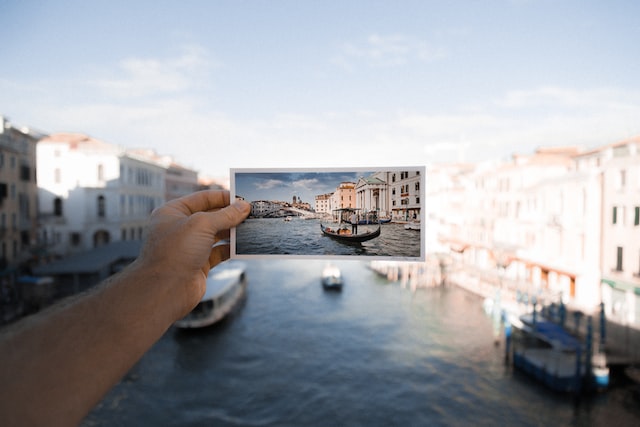Artist Mickalene Thomas takes on Monet, and art history itself
For “Mickalene Thomas: Avec Monet,” the American artist created works that reflect on the French painter and move Black women into the foreground
Thomas, 51, has built her substantial art-world reputation by focusing on Black women and presenting them not as uniquely heroic or long-suffering, not as tools for cultural propaganda, but as self-affirming, sensual beings. Thomas hints at their complicated and layered identities with her use of collage; she heightens their beauty and glamour by incorporating crystals and rhinestones; she underscores their power with an aesthetic pulled from the “Black is beautiful” era of the 1970s. Thomas’s women often look as though they have stepped from a blaxploitation film, the pages of Ebony or Jet magazines, or the imagination of someone who keenly understands the importance of celebrating your own fabulousness when the world is stubbornly blind to it.
“We, too, can recline,” Thomas declares. “We, too, can relax and be seen doing so and have it be empowering and validating for our sense of self. We can be in the moment and in own our space and not be seen as being lazy.”
Her studio inside that bland building is light-filled and sprawling with high ceilings and plenty of room for pieces that are still in process, those that are complete, as well as an office area where she has settled into an uncomfortable-looking chair but one that has her slightly elevated above the facing sofa. It is the boss chair.
Thomas is a tall, sturdy woman with braids and deep brown, unlined skin that gives the illusion of porelessness. Her voice is warm and smooth, with the unaccented cadence of someone who has lived on both American coasts, as well as in Europe. She enunciates with the measured specificity of an English teacher, even though art has always been her vocation. She wears a T-shirt with a picture of the rapper Tupac Shakur. For an artist so devoted to the stories of Black women, the complicated poet of hip-hop is one of two exceptions to her fashion rule.
“I’m on this journey of collecting T-shirts with Black women,” Thomas explains. “I was going to wear my Janet Jackson one. I only have Biggie and Tupac as the men. Then it’s all the women, like Eartha Kitt, Whitney Houston. They’re my studio shirts.”
Thomas is a distinctive and recognizable cultural figure. She’s had a multitude of exhibitions, including at the Brooklyn Museum, the Wexner Center for the Arts in Columbus, Ohio, and numerous galleries. She moves effortlessly between the fine art world of mixed media and fashion’s universe of photography — between high art and artful consumerism — sometimes blending the two so that a supermodel and a frock convey a universe of complications. In her 2013 portrait “Naomi Looking Forward #2,” a reclining Naomi Campbell, her hair and lips encrusted with crystals, offers commentary on the 19th-century “La Grande Odalisque.” Thomas, herself, regularly makes a fine model, sometimes in a Gucci suit on the cover of a magazine, sometimes as the star of her own video installation.
Thomas’s fine art is now the subject of an exhibition that opened in October at the Musée de l’Orangerie in Paris. The museum, in the Tuileries Garden, is known as the permanent home for eight of Claude Monet’s waterlily paintings. The exhibition organizers asked Thomas to create works that reflect on Monet and the time she spent as an artist-in-residence at his former home in Giverny, France, in 2011.
“Mickalene Thomas: Avec Monet” is her first exhibition at a museum in France. And geography means something. The show centers her at both the physical and artistic heart of Paris — or at least the version of the city that most of the world knows. Instead of having her work considered solely in the context of the present, it’s presented in relationship with the past; it’s dancing with the ghost of one of art history’s titans. The small museum was constructed in 1852, and over time, its collection has helped to tell the erroneous story of French art, establishing a narrative that European art is White when, in fact, it is Asian and African, too. Thomas disrupts that story in ways both obvious and subtle, by her mere presence and with her work.
“I feel very honored,” Thomas says. “Look, I’m a Black girl from Camden, New Jersey. Every once in a while, I’ve got to pinch myself: Is this happening? This is something that is a reality? Is possible?
“I never thought that I would have my first exhibition in conversation with Monet. I thought, actually, I would have a show at the Pompidou or something like that because it’s more of a contemporary museum,” she adds. “But I think this historical museum, in some ways, makes a lot of sense with my body of work over the years.”
Thomas attributes the existence of her exhibition to an art-world reckoning of sorts. In 2018, the Wallach Art Gallery at Columbia University presented “Posing Modernity: The Black Model From Manet and Matisse to Today,” which explored how the Black female form was essential to the development of modern art and the manner in which Black women were represented. The exhibition later traveled to the Musée d’Orsay.
“The Black model was always present but was omitted from the conversation,” Thomas says. “I think because of that [exhibition’s] exposure, because of that conversation around the Black model and looking back into history … we’re open to forging forth with some of these conversations that we’ve so long kind of circled around.”
In 2022, she created “Le Déjeuner sur l’herbe: Les Trois Femmes Noires avec Monet.” The mixed-media composition installed at l’Orangerie, along with three other collage paintings and photographs, as well as a video composition, depicts three women at rest in a landscape they have claimed as their own. Thomas created it in response to Monet’s “Le Déjeuner sur l’herbe,” which followed Édouard Manet’s painting of the same title. Like her predecessors’, Thomas’s work is lush with flowers and trees. But instead of ivory-skinned picnickers and sunbathers, she positions Black women in their glory, with brown skin and Afros. They look back at the viewer. They aren’t staking a claim on a White world; they’re inhabiting their own realm, one in which Monet exists but over which they have authority. They’re at ease and self-satisfied.
In “Salle à Manger et Sofa avec Monet,” the dining room of Monet’s home is reimagined to incorporate parts of Thomas’s realm, including a pale yellow sofa that has served as something akin to a throne for the subjects of her portraiture.
Thomas’s aesthetic — not just the pieces at l’Orangerie, but her entire body of work — is a corrective. It’s a reclamation of history and future history.
“What I respond to and admire and visually love about Mickalene’s work is she doesn’t shy away from the 19th-century images because they’re fraught with all the layers and stereotypes of women of color,” says Denise Murrell, who curated the “Posing Modernity” show in New York. “She reimagines these images and gives us a sense of the subject and how these women would have, could have been seen by themselves or been seen by others.”
Murrell zeroes in on one of Thomas’s works from 2012, “Din, Une Trés Belle Négresse 1.” It features a Black woman dressed in a floral print and posed against a floral backdrop. She’s wearing a large shell necklace, and her hair is styled in a grand Afro that surrounds her face like a sacred halo. Her full lips are lacquered in a deep blackberry hue, and her eyes are dramatically highlighted in dark shadow. The title, translated, means Din, A Very Beautiful Black Woman, but Thomas uses the discomforting “négresse,” which in art history often has rendered individual Black women as an anonymous commodity.
“She’s taking all the physical features, the hair and lips, that have been stereotyped in a derogatory way in the 19th century and giving them full beauty and lushness. She’s not just presenting a 19th-century woman, but the woman of the current moment,” says Murrell, who is the Merryl H. and James S. Tisch curator at-large at the Metropolitan Museum of Art.
In Thomas’s portraits, “the attire is of the late 20th century, the pose, the affect, the stance. You could see them at parties or on the street. She’s making these arguments in the artistic language of the current moment,” Murrell adds. “They’re gorgeous and self-possessed. They’re the opposite of the pictorial subordination in previous depictions of Black women. They claim all aspects of their being.”
Thomas’s aesthetic was shaped, in part, by the world as presented in the pages of Ebony and Jet. They were on the coffee table of her home growing up, and they helped to define beauty and success among people who looked like her. The magazines, Thomas says, “had such a profound way of communicating to me as a young girl. It was where I first saw beauty and read about Diahann Carroll and all these moments of celebration of what Black folks were doing.
“It was really a window into a world outside of my world.”
What stays with her, though, is not just the outsize success of actors and business people, but also the smaller, notable moments acknowledged in those magazines. A person didn’t have to be one-of-a-kind to be noticed, to have their life documented in print. They could simply be an outstanding doctor or a college student or a piano teacher. They could simply be pretty. Today, the breadth of media, particularly social media, enhances the fame of the few but can blind the culture to everyone else. The beautiful, determined quotidian is ignored.
Thomas’s work responds to that lapse. Her women mostly aren’t famous, but they’re treated as extraordinary. They’re bedecked with crystals. They’re draped in florals and leopard print. They’re made up like starlets.
In Thomas’s work, her mother, Mama Bush as she’s called, is stylized, but also raw. Her mother struggled with addiction and suffered physical abuse, and Thomas photographed her often before her 2012 death. As a school project when she was attending Pratt Institute, Thomas photographed her mother dressed up like actress Pam Grier. Her mother, who had some experience modeling, warmed to the task, enjoying the role-play and, in particular, the fashion.
“Most Black people, we’re going to present ourselves a certain way,” Thomas says. “I think that comes from owning yourself and being present and making sure you’re treated and respected when you’re walking through spaces.”
In another portrait, “Madame Mama Bush,” her mother is reclining on a slipcovered sofa. When her red negligee fell open to reveal her breasts, she didn’t move to cover herself. She simply and quietly told her daughter: “Just take the damn pictures.”
The images — along with others Thomas took over the years — are intimate and self-confident from the perspective of both subject and artist. Her mother reveled in her body for Thomas’s camera, but also exposed her interior self during the sitting as the two discussed sex, men and the challenges of both.
“We didn’t always have the best relationship, and it’s not because she was a bad mother or she was a bad person. She had challenges in her life. She was human. And as I got older, I recognized that,” Thomas says. “Our relationship got closer through art. It was such a beautiful way of communicating with each other, and I learned a lot about myself, working with her, because I began to see the things that I was sort of pushing up against. I had to just, sort of, let my shoulders down and be open.
“Once we started collaborating, she was open to expressing herself within my art freely. I was so overwhelmed and blown away with her vulnerability and her strength and her willingness to just be free with her own sensuality and sexuality. It was a way for her to share herself.”
Her mother was empowered by Thomas’s lens. The act of making art created a kind of invincibility. Art creates a space where people can exist outside themselves.
Thomas realized this when she was in her early 20s and had an “aha” moment after seeing a Carrie Mae Weems exhibition at the Portland Museum of Art. It was Weems’s “Kitchen Table Series,” a collection of photographs set at a kitchen table that tell the story of love, loneliness, friendship, motherhood and self-reflection from the perspective of a Black woman — but really, women in general.
“I’m not that person that gets high, but I imagine this euphoria, this moment where you just feel like you can do anything,” Thomas says. “That’s what I saw. That’s what I felt when I saw Carrie Mae Weems [artworks] and being like, ‘I can do anything. I know this. I’m that little girl. I’m that person. I recognize these images.’ That was the first time I saw images of Black women, a Black family, in contemporary art. And that hit me so deeply. It’s like: ‘Wow, I didn’t know art could do this.’
“So whatever that sort of thing is that triggers someone positively, that’s what I want,” she says. “That’s why I became an artist.”
It’s late September and the works that Thomas has created for the Paris show are still in her Brooklyn studio. One of them, “Le Jardin d’Eau de Monet,” is in pieces. Its panels will be conjoined once they cross the Atlantic, and the museum visitor will have the experience of being immersed in Thomas’s world.
The work comprises photography and collage and, of course, rhinestones. At a distance, it’s a joyous celebration of nature. Up close, it’s Monet environment subordinated to Thomas’s. Instead of the meditative, indulgent serenity of Monet, one sees the urgent energy of Thomas with her deep faith in her own agency.
Although it’s a landscape, the work isn’t such an extreme departure from the sensibility and vision that has brought Thomas acclaim, which is her exploration of Black female sensuality and self-awareness; it’s a continuation along that artistic road. One could easily imagine one of Thomas’s women reclining languidly in “Le Jardin d’Eau de Monet,” but they don’t have to be present for their ownership to be evident. It’s still clear that this landscape, this space, belongs to Thomas and her muses.
The Paris show was an opportunity to express a specific kind of freedom and luxury that she discovered at Giverny.
“I really was inspired, during my time there, by how [Monet] as an artist really created space for himself and resource material to work from on a day-to-day basis. Like he could wake up and just have this landscape that he’s created,” Thomas says. “He specifically chose the flowers; he specifically created the pond in a very particular way. Everything was strategic for him — how he moved around and walked through this space.”
The ability to create, control and then thrive in one’s environment is a reflection of power and an enormous source of comfort. A viewer doesn’t have to know anything about the history of art to be moved by this idea. Anyone who has lived within the context of 21st-century culture might understand hashtags such as #Black Lives Matter and #BlackExcellence as not only political statements and personal affirmations, but also declarations of one’s right to simply “be.”
Thomas thought of this one midsummer day in Fort Greene Park. She saw a young Black couple who had tied a hammock between two trees. They weren’t doing anything remarkable. And that, to Thomas, was worth noting.
“They just claimed the spot. They were the only ones in the park with a hammock, and they just laid on it and swung and laughed,” she recalls. “I wanted to just bottle that. It was so beautiful.”
Instead, she has painted that joy and sense of relaxation. She has installed it in the center of Paris. At the heart of art history. Because geography means something.







